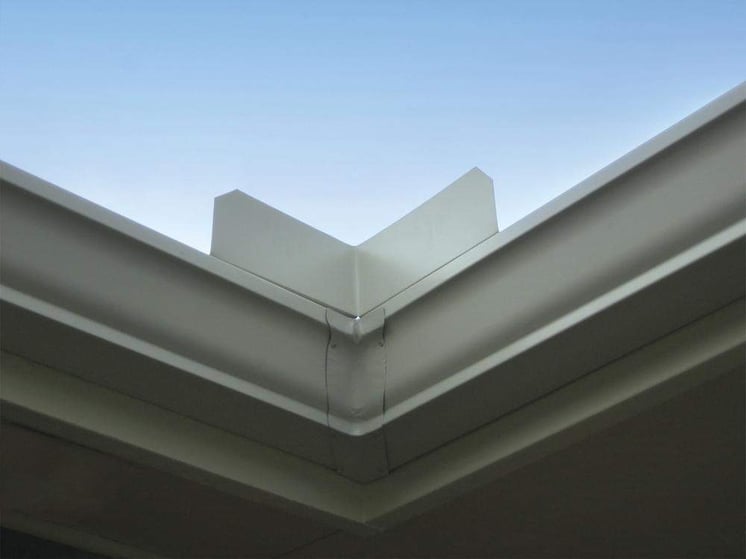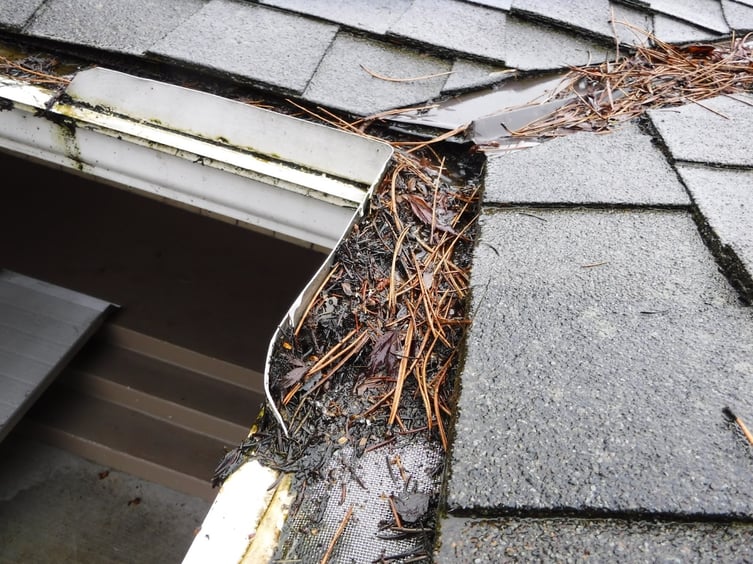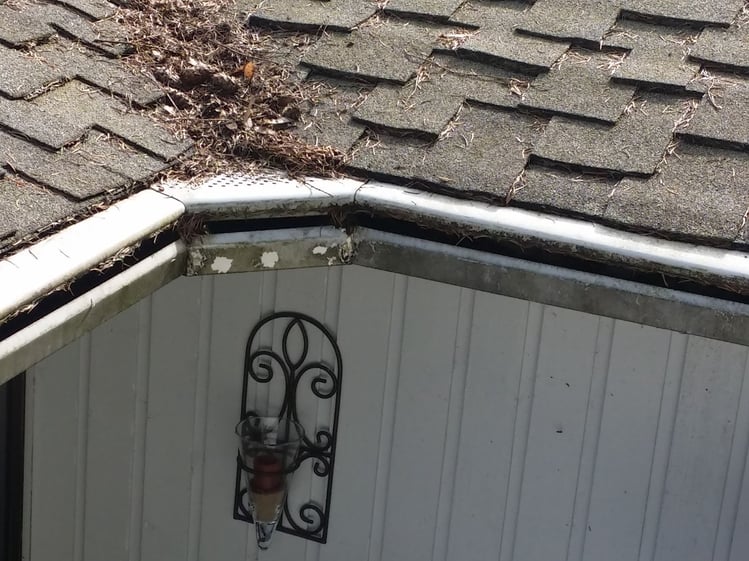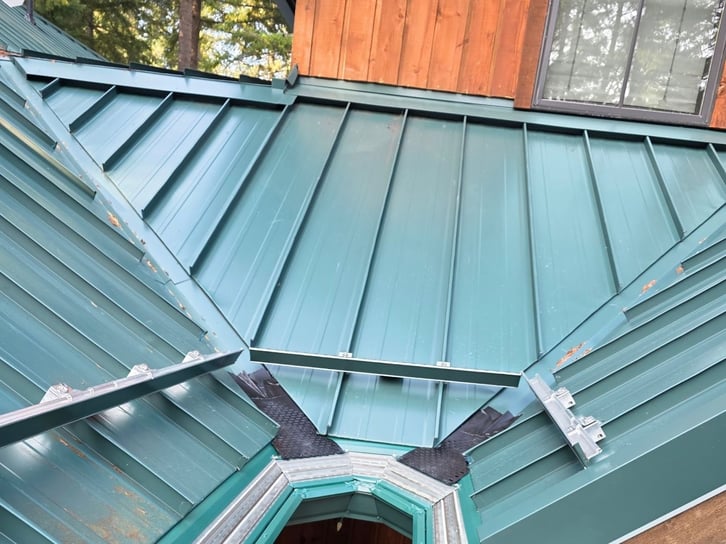Why Does My Gutter Guard Clog at the Valley?
November 26th, 2025
4 min read

Have you noticed water overshooting your gutters during heavy Seattle rain, especially where two roof slopes meet? Are you frustrated because your expensive gutter guard system still lets water spill over, leading to algae growth, muck buildup, or even foundation issues?
Roof valleys are one of the trickiest spots on your home for water management. They collect debris faster, carry heavier water flow, and are more prone to clogs and overflow, especially when a gutter guard isn’t properly designed for that specific area.
At RoofSmart, we install hundreds of gutters and gutter guards every year. Each time, we help the homeowner identify their gutter issues and find the right gutter guard to protect their roof, even when we need to make special modifications to help prevent extra clogging.
In this article, we’ll explain why standard gutter guards struggle at roof valleys, what damage this can cause to your home, and what specialized solutions can actually fix the problem.
Why are gutter guards more likely to clog at the valley?
It seems like gutter guards are designed for straight runs of gutter, but if the gutter has a corner where it hits a valley, this can cause issues. Gutter guards will typically just clog if they get hit with a bunch of debris at once from the valley.

They're all designed to have water hit them straight on, not at an angle. Since gutter guards get turned at an angle to accommodate the shape of the valley, this means the gutter guard isn’t even working properly in that area.
Roof valleys generally tend to get a lot of debris buildup because that’s where water and debris are naturally supposed to run. The problem comes when this debris runs down the valley into the gutter.
If the gutter is just open, you’ll have a bunch of debris that piles up and creates a clog. But even with a gutter guard, the debris from the valley will just pile up on top of the gutter. Most gutter guards are flat and just collect debris over time.
Can clogged gutter guards damage my roof?
As a result of the clogging in the valley, the water will shoot over the debris and onto the ground. This can even happen with a small amount of debris.
A common “solution” to this problem is to add a diverter on the edge of the gutter:

These are meant to block water from shooting over the edge of the gutter, even when there is some debris that gets piled up.
However, these diverters don’t always work as intended and can sometimes even cause more issues:
- The debris will deteriorate and start growing algae: The debris will continue to pile up in the corner at the valley. The gutter guard is flat, and there is a barrier keeping the debris from going anywhere, so it just sits. Eventually, it’s going to deteriorate and create muck. Algae and moss will start to grow underneath it, clogging the gutter guard itself so that no water is getting through it. Micromesh gutterguards are especially in danger of clogging with muck and algae.

- Water can overshoot and damage your home’s foundation: Over time, the debris will continue to pile up behind the diverter. This creates a ramp of sorts for the water coming down the valley to shoot off of. So now, you have a clogged gutter that’s sending water down to the ground. Depending on how long this goes on and how much rainfall you get, this can damage your home’s foundation and potentially cause flooding.
Water should not be shooting (or even dribbling) down the outside of your gutters. A less extreme, but still gross consequence is that your gutter can start to grow algae all over.

In some cases, a diverter can be useful, but it usually ends up causing a lot of extra problems on your roof, especially if you live on a property with a lot of trees. The debris is just going to keep piling up, especially if you have a lot of pine or fir trees. You need to make sure that the debris can be removed and isn’t getting extra clogged; otherwise, the clogging won’t ever stop.
Which gutter guards are designed to prevent clogging at the valley?
There are two gutter guards that I know of (like in the world) that handle valleys well. One is Leaf Guard, and the other is MasterShield. The solution is to make a piece that fits into the corner instead of cutting pieces up and meeting them at a diagonal to make a corner.
Leaf Guard has designed a corner piece that fits into spots on the roof where the valley meets the gutter, which allows the water and debris to hit that section of gutter straight on, just like it does along the rest of the roof.
This is what it looks like in action:

Even though there is built-up debris in the valley, the water will not overshoot because it can filter through the top or still follow the curve down and into the gutter.
At RoofSmart, we can make custom corner pieces for our MasterShield customers. We bunch of custom sheet metal work to make what we call a “big mouth” inside corner. This is what it looks like:

Here’s what it looks like from underneath:

Just like with the Leaf Guard example, this makes it so that the water hits the gutter guard at a perpendicular angle, just like the rest of the roof.
Will All Gutter Guards Clog on My Seattle Home?
If you're noticing persistent clogs where your roof valleys meet the gutters, you're not alone, and that might only be one of several issues lurking beneath the surface. Seattle’s unique climate, heavy tree coverage, and relentless rain expose the flaws in many gutter guard systems, especially the popular DIY or off-the-shelf types.
But what if your gutter problems aren’t just about the valley? What if the entire system isn't built to handle the Pacific Northwest at all?
Before you invest in a fix that doesn’t fully solve the problem, take a step back and understand the bigger picture of why gutter guards often fail in Seattle homes.
The next article breaks down the most common failure points and what you can do to avoid them: Why Do Most Gutter Guards Fail in Seattle (and What Actually Works)?
Jim Singleterry is the CEO and founder of RoofSmart. He is passionate about getting to the root of each customer's roofing problems and helping them find the right solution for their roof.
Topics:


